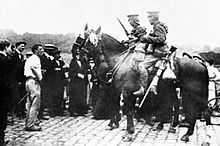18th Royal Hussars
| 18th Royal Hussars (Queen Mary's Own) | |
|---|---|
| Active |
1759–1821 1858–1922 |
| Country |
|
| Branch |
|
| Type | Cavalry |
| Role | Line Cavalry |
| Size | 1 Regiment |
| Nickname |
The Young 15th The Drogheda Light Horse |
| Motto |
Pro rege, pro lege, pro patria conamur (For King, for Law, for Country we strive) |
| Commanders | |
| Notable commanders |
Field Marshal Charles Moore, 1st Marquess of Drogheda |
The 18th Royal Hussars (Queen Mary's Own) was a cavalry regiment of the British Army, first formed in 1759. It saw service for two centuries, before being amalgamated into the 13th/18th Hussars in 1922.
The regiment was first raised as the 19th Regiment of (Light) Dragoons in 1759, renumbered the 18th Regiment of (Light) Dragoons in 1763, and briefly the 4th Regiment of Light Dragoons in 1766 before settling on the 18th in 1769. In 1805 it took the title of the 18th (King's Irish) Regiment of (Light) Dragoons, named for George III, and redesignated as hussars in 1807, becoming the 18th (King's Irish) Regiment of (Light) Dragoons (Hussars). It was informally known as the "Drogheda Light Horse" and it was humorously referred to as the "Drogheda Cossacks." It was disbanded in Ireland in 1821.
The regiment was reformed in 1858, as the 18th Regiment of (Light) Dragoons from a nucleus taken from the 15th Hussars, and renamed the 18th Hussars in 1861. In 1903 it was named the 18th (Princess of Wales's Own) Hussars, for Princess Mary, being retitled the 18th (Victoria Mary, Princess of Wales's Own) Hussars in 1905 and the 18th (Queen Mary's Own) Hussars in 1910 to mark her coronation as Queen Consort. After service in the First World War, the regiment retitled as the 18th (Queen Mary's Own) Royal Hussars in 1919, then the 18th Royal Hussars (Queen Mary's Own) in 1921, and was amalgamated with the 13th Hussars to form the 13th/18th Hussars the following year.
Battle honours
- Peninsula, Waterloo, Defence of Ladysmith, South Africa 1899-1902
- The Great War: Mons, Le Cateau, Retreat from Mons, Marne 1914, Aisne 1914, La Bassée 1914, Messines 1914, Armentières 1914, Ypres 1914 '15, Gravenstafel, St. Julien, Frezenberg, Bellewaarde, Somme 1916 '18, Flers-Courcelette, Arras 1917, Scarpe 1917, Cambrai 1917 '18, St. Quentin, Rosières, Amiens, Albert 1918, Hindenburg Line, Pursuit to Mons, France and Flanders 1914-18
See also

References
Bibliography
- Mills, T.F. "18th Royal Hussars (Queen Mary's Own)". regiments.org. Retrieved April 5, 2007. Includes chronological index of titles.